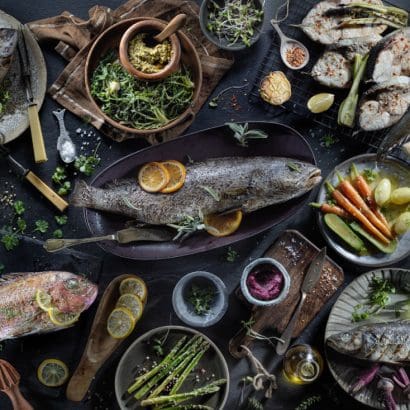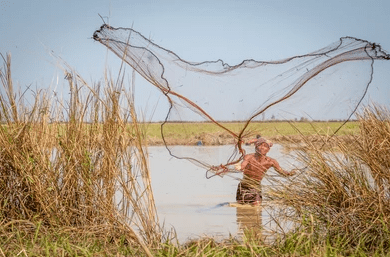
Indigenous fishing traditions are a fundamental part of the culture and identity of many native communities around the world. These ancestral practices not only represent a source of sustenance but also a deep connection with nature and a way of life that has endured for generations. In this article, we will explore the various techniques and rituals of indigenous fishing, their cultural significance, and how these traditions are being preserved today.
Contents
Indigenous Fishing Techniques.🐟
Nets and Traps.
Nets and traps are essential tools in many indigenous fishing traditions. These techniques vary widely between different cultures and regions, adapting to environmental conditions and the available gorguera fish and other species.
Fishing Nets.
Fishing nets, handwoven with natural materials such as plant fibers, are used by many indigenous communities to catch large quantities of fish. For example, indigenous people in the Amazon use chambira fiber nets, a native plant, to fish in the rushing rivers.
Fishing Traps.
Fishing traps, on the other hand, are ingenious devices designed to catch fish without constant supervision. Traps can be constructed with bamboo, wicker, or other natural materials and are strategically placed in water currents. Cone-shaped traps, for instance, are common among indigenous communities in Southeast Asia.
Spearfishing and Harpooning.
Spearfishing and harpooning are traditional techniques that require great skill and precision. This practice is common among indigenous communities living near clear bodies of water, where visibility allows fishermen to aim and throw their weapons effectively.
Underwater Fishing.
In some regions, indigenous people practice underwater fishing using handmade harpoons. This technique is not only effective for catching fish but also a sport requiring great dexterity and physical endurance. Hawaiian indigenous people, for example, are known for their underwater fishing skills, using wooden and bone harpoons.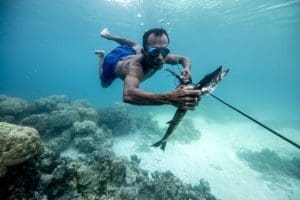
Use of Plants and Natural Poisons.
Some indigenous communities use plants and natural poisons to facilitate fishing. These substances are generally non-toxic to humans but effective at stunning or killing fish, making them easier to collect.
Piscicidal Plants.
In the Amazon, certain plants contain chemical compounds that, when released into the water, affect the fish without contaminating the environment. Barbasco, a plant containing rotenone, is used by several communities for this purpose. The stunned fish float to the surface, where they can be easily collected.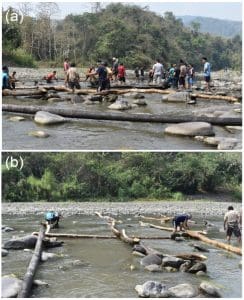
Cultural Significance of Indigenous Fishing Traditions.🐟
Spiritual Connection with Nature.
For many indigenous communities, fishing is not just an economic activity but also a spiritual practice. Fishing traditions are often imbued with rituals and ceremonies that honor the spirits of the water and marine creatures.
Rituals and Ceremonies.
Before the fishing season begins, some communities perform ceremonies to ask permission from the water spirits and ensure an abundant catch. These rituals may include offerings, chants, and dances, and are an expression of respect and gratitude towards nature.
Transmission of Knowledge.
Fishing traditions are passed down through generations via practical teaching and oral storytelling. Knowledge about fishing techniques, seasons, and customs is shared by the elders of the community with the younger members, ensuring the continuity of these practices.
Intergenerational Education.
Young people learn by observing and participating in fishing activities alongside their elders. This educational process not only focuses on technical skills but also instills a deep respect for the environment and cultural traditions.
Conservation and Modern Challenges.🐟
Threats to Fishing Traditions.
Indigenous fishing traditions face numerous challenges in the modern world, including overfishing, pollution, and climate change. These threats not only affect the availability of fish resources but also endanger the preservation of cultural practices.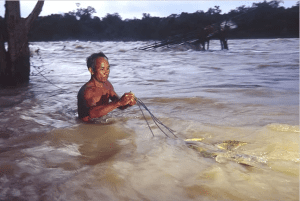
Overfishing and Pollution.
Industrial fishing and water pollution have significantly reduced fish populations in many areas. This not only hinders traditional fishing practices but also affects the food security of indigenous communities.
Conservation Efforts.
Despite these challenges, many communities and organizations are working to preserve and revitalize indigenous fishing traditions. Conservation efforts include the creation of protected areas, the implementation of sustainable fishing practices, and the promotion of environmental education.
Protected Areas and Reserves.
The creation of protected areas and indigenous reserves allows communities to manage and conserve their fish resources sustainably. These zones provide a refuge for aquatic species and ensure that future generations can continue practicing their fishing traditions.
Education and Awareness Programs.
Education and awareness programs about the importance of fishing traditions and environmental conservation play a crucial role in preserving these practices. These initiatives foster respect for indigenous cultures and promote sustainable management of natural resources.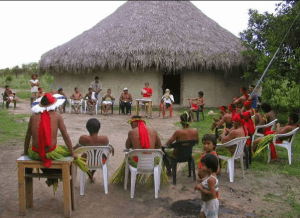
Conclusion.🐟
Indigenous fishing traditions are a testament to the harmonious relationship between humans and nature. Through ingenious techniques and a deep spiritual connection with their environment, indigenous communities have developed sustainable practices that have endured over time. Preserving these traditions is vital not only for the cultural identity of these communities but also for the conservation of aquatic ecosystems worldwide.
Asked Questions about Indigenous Fishing Traditions.
As we delve deeper into the rich and diverse world of indigenous fishing traditions, it is important to address some common questions that often arise. These questions help us understand the practical aspects, current challenges, and future prospects of these age-old practices.
What fishing techniques do indigenous communities use?
Indigenous communities utilize a variety of fishing techniques that are often tailored to their local environments and available resources. Some common techniques include:
- Fishing Nets: Handwoven from natural fibers, these nets are used to catch large quantities of fish in rivers, lakes, and oceans.
- Fishing Traps: Constructed from materials like bamboo or wicker, these traps are strategically placed in water currents to capture fish.
- Spearfishing and Harpooning: This technique involves using handmade spears or harpoons to catch fish, often practiced in clear waters where visibility is high.
- Use of Piscicidal Plants: Some communities use plants that release natural toxins into the water to stun fish, making them easier to collect.
These methods reflect a deep knowledge of local ecosystems and sustainable practices developed over generations.
How does climate change affect indigenous fishing traditions?
Climate change poses significant threats to indigenous fishing traditions by altering the ecosystems that these communities depend on. Key impacts include:
- Changes in Fish Populations: Rising temperatures and shifting weather patterns can affect the distribution and abundance of fish species, making traditional fishing grounds less productive.
- Habitat Degradation: Increased frequency of extreme weather events, such as storms and flooding, can damage aquatic habitats and disrupt spawning cycles.
- Water Quality: Changes in precipitation and runoff patterns can lead to water pollution and decreased water quality, further impacting fish populations.
These changes threaten the food security and cultural practices of indigenous communities, necessitating adaptive strategies to maintain their fishing traditions.
What are the main challenges for the conservation of indigenous fishing traditions?
The conservation of indigenous fishing traditions faces several significant challenges:
- Overfishing: Industrial fishing practices can deplete fish stocks, reducing the availability of resources for indigenous communities.
- Pollution: Contamination of water bodies from industrial, agricultural, and urban sources can harm fish populations and the health of those who consume them.
- Loss of Traditional Knowledge: As younger generations migrate to urban areas or adopt modern lifestyles, there is a risk of losing the traditional ecological knowledge and skills associated with indigenous fishing.
- Legal and Political Issues: Indigenous communities often face legal and political obstacles in securing rights to their traditional fishing areas and resources.

